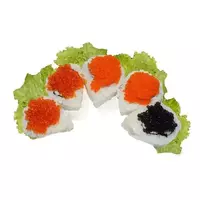Artificial caviar

In its biological essence, a food like caviar is a mass of fish eggs, as well as amphibians, echinoderms and molluscs. From a culinary point of view, caviar is an edible mass consisting of eggs of various species of marine life. People began to eat caviar at the initial stage of the formation of human civilization.
Currently, the following classification of caviar is used in the food industry: sturgeon or black, salmon or red, particle, white caviar or shellfish caviar, as well as snails and artificial caviar. At all times, the first two types of caviar were especially popular and in demand. Red and black caviar also occupy a special place in the domestic culinary tradition.
A few decades ago, in order to get a jar of coveted and delicious caviar for the holidays, you had to stand for many hours in line. Nowadays, any type of caviar can be freely purchased in grocery stores. It is worth noting that recently artificial caviar has become more and more popular. the so-called synthetic or artificial caviar is a surrogate food product, which only in taste and appearance resembles natural fish caviar.
Most often imitate the popular red and black caviar. In appearance, it is quite difficult to determine where natural or artificial caviar is. Artificial caviar is certainly different in taste from natural caviar. The main feature of artificial caviar is the composition and method of product production. Artificial caviar gives the taste of margarine.
In fact, artificial caviar is gelatin balls with a taste of fish. The first imitation of caviar was created in the USSR back in the 60s of the last century. The authorities set the task for scientists to invent a publicly available type of caviar that people with different incomes and status in society can acquire. The first artificial caviar was made from protein raw materials. The artificial caviar production process involved ingredients such as chicken eggs, as well as vegetable oil and food additives.
The technology for making artificial caviar consisted in the formation of round eggs of the correct shape from a pre-prepared protein mass. It is noteworthy that the first version of artificial caviar did not particularly appeal to even such an inexperienced gastronomically public as residents of the USSR.
The product so vaguely resembled natural caviar that experts decided to completely process both the composition and the production technology. In Soviet times, there were rumors that artificial caviar was produced from oil, as well as fish eyes. Despite the complete absurdity of such statements, in our time many people are wary of artificial caviar.
Modern manufacturers of artificial caviar use the so-called gelatin technology in the process of manufacturing a product. In addition, in the production of high-quality and expensive types of artificial caviar, meat of valuable fish species is used. As well as seaweed extracts.
artificial caviar 64 kCal
Energy value of artificial caviar (Ratio of proteins, fats, carbohydrates - ju):
Proteins: 1 g (~ 4 kCal)
Fats: 5 g (~ 45 kCal)
Carbohydrates: 2.6 g (~ 10 kCal)
Energy ratio (bj | y): 6% | 70% | 16%
 Español
Español Français
Français Português
Português Русский
Русский 简体中文
简体中文 繁體中文
繁體中文 日本語
日本語 한국어
한국어 العربية
العربية Türkçe
Türkçe Қазақ
Қазақ Deutsch
Deutsch Italiano
Italiano Українська
Українська
